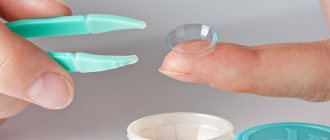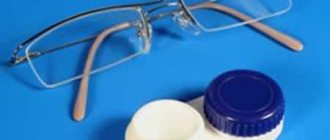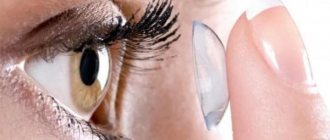Recommendations
- Always disinfect your lenses thoroughly;
- If you notice any damage on the surface of the lenses, stop using them;
- If you feel any discomfort while wearing lenses or after removing them, contact your ophthalmologist;
- if the lens is stuck and removing it causes discomfort, drop a couple of drops of a special moisturizing solution into the eye and remove it as usual;
- to avoid mixing up the lenses, label each container with the letters “P” (right) and “L” (left);
- Be sure to change your lens containers at least once a month!
RIGID GAS PERMEABLE LENSES (GPL)
Keratoconus is a dystrophic disease of the cornea, which leads to its cone-shaped protrusion. Most often, the disease manifests itself between the ages of 15 and 25 years. The first symptoms: increasing myopia (due to increasing curvature of the cornea, and not due to the growth of the eyeball) and the same increasing astigmatism due to deformation of the cornea. After just a year, previous glasses become weak and uncomfortable, and vision in new glasses with large cylinders becomes increasingly worse.
Symptoms of Keratoconus in itself:
- progressive myopia in adulthood
- monocular diplopia
- appearance of a double circuit
- halo, image distortion more than fog
- frequent eye itching
- corneal distortion
- the appearance of irregular astigmatism
- decreased visual acuity
- steep keratometry values with distortion of marks.
Gas permeable rigid lenses for keratonicus are divided into 2 significant groups depending on the size:
1. Corneal lenses from Rose K
These lenses have a small diameter - 8-10 mm. These lenses are the most widely used and are most often used for keratconus. But even these can have different designs and work differently in different patients. Doctors often have to have 2-3 sets of different corneal keratoconus lenses to choose from for different situations.
2. So-Clear corneoscleral comfort lenses have a large diameter (14.0mm)
SoClear lenses are large diameter (14.0 mm) rigid gas permeable contact lenses. Designed to correct visual impairment from +20.0 to -20.0D.
The peripheral part of the lens rests on the sclera, there is no contact between the lens and the cornea, so SoClear lenses are surprisingly comfortable compared to conventional hard lenses. They are extremely stable on the eye and have little movement.
Highly gas permeable material provides crisp, clear vision without the problems associated with corneal rigid gas permeable lenses:
- lens sensation
- increased sensitivity to wind or foreign bodies
- lens falling out, etc.
These advantages make SoClear a good choice both for solving problems in difficult cases (post-operative astigmatism, keratoconus), and sometimes even as a “first choice” lens when hard and soft contact lenses are poorly tolerated.
Corneoscleral lenses are suitable for:
- patients with keratoconus and postoperative keratectasia, if it is impossible to select soft or hard corneal contact lenses
- patients with an altered shape of the cornea due to trauma, surgery, implantation of stromal segments (Intacs)
- patients with myopia or farsightedness with astigmatism who are not satisfied with the visual acuity in soft contact lenses or cannot tolerate hard contact lenses.
- patients with dry eye symptoms
- patients with postoperative astigmatism or corneal scars
- patients with high myopia or farsightedness (up to +/- 20.0D), as well as in combination with astigmatism, when the selection of toric lenses is limited.
What are soft eye lenses made of?
Hydrogel
In the 60s of the 20th century, the first hydrogel polymer materials for contact correction products were synthesized, including HEMA hydroxyethyl methacrylate. They had increased hydrophilicity, that is, the ability to attract water. Almost 38% of these polymers consisted of water, which, in fact, delivered oxygen to the cornea. However, to supply the eyes with nutrients, it was necessary that the tear fluid continuously flow under the surface of the optical product. In the late 60s, Bausch & Lomb, the largest manufacturer of contact lenses, received a license to manufacture HEMA material, as well as a special technology for molding soft contact lenses. This is how the Optima FW and Soflens 59 models, made from hydrogel, appeared on the ophthalmological market.
It should be noted that almost all modern hydrogel optical products from most manufacturers have the same oxygen permeability, which varies between 20-30 (Dk/t). This is enough to safely wear contact correction products throughout the day. However, it will not be possible to use these models continuously over a long period.
Advantages of hydrogel lenses:
- Quick adaptation period.
- Affordable price.
- Comfort and safety of wearing (in daytime mode).
Disadvantages of these optical products:
- Impossibility of long-term operation (in flexible, prolonged or continuous mode).
- Low oxygen permeability - within 30 (Dk/t).
- Possible redness of the eyes at the end of the day when worn in rooms with excessively dry air.
Silicone hydrogel
Currently, silicone hydrogel lenses for eyes are very popular. They are a combination of two copolymers - hydrogel and silicone. The first is the basis of the material, and the second is responsible for oxygen access to the cornea.
Silicone is hydrophobic, so the contact lens already contains moisture and has a high Dk/t value, regardless of whether tear fluid enters under it or not.
Thanks to this, silicone hydrogel ophthalmic products can be used continuously for a long time. Some models can be used for up to 30 days without removing (after consultation with an ophthalmologist). At the same time, the eyes do not turn red because they do not experience oxygen starvation.
Advantages of silicone hydrogel lenses for eyes:
- Higher level of breathability than hydrogel ones (up to 170 Dk/t).
- Possibility of operation for a long time - in flexible, prolonged or continuous mode.
Disadvantages of these optical products:
- Higher cost compared to hydrogel products.
- Longer adaptation period.
- Tendency to dehydration.
- Individual intolerance to silicone hydrogel material is possible.
It should also be noted that the presence of silicone in the lens increases its elastic modulus. The more volume of this material is contained, the stiffer the optical product becomes. This makes the product more fragile. In addition, an increase in the volume of silicone leads to a decrease in moisture content, which contributes to dehydration (drying) of the lens.
Now you know what contact lenses are made of. We recommend that you familiarize yourself with the manufacturing methods of these optical products.
What types of lenses are available based on wear time and replacement schedule?
Which contact lenses should you choose? This largely depends on the period of wearing and replacement regimen, which the ophthalmologist considers most suitable for you. Today they highlight:
- day mode, designated as DW. Such lenses must be removed before going to bed;
- flexible, or FW. These optical products can be left in place for two to three days;
- extended, or EW. Such correction products can be used for a month without removing.
What are the terms of use of optical products? The safest are:
- one-day;
- weekly;
- two weeks;
- monthly.
How long you can wear these lenses is clear from the name. Some models can be used in daytime, flexible and prolonged modes.
Also on the modern market are optical products that can be worn during:
- three months;
- six months;
- of the year;
- 18 months.
The presented modes are designed for long-term wearing. Such lenses are considered less safe, but they are much cheaper than, for example, one-day lenses, which is why many users choose them.
What contact lenses are used to correct vision?
Let's start with the fact that the main contact lenses for many years have been optical ones. They are designed to correct common refractive errors today: myopia and farsightedness. Particularly popular among modern buyers are such models as:
- Acuvue Oasys with Hydraclear Plus;
- Soflens Daily Disposable by Bausch + Lomb;
- Biofinity from CooperVision;
- Air Optix Aqua from Alcon;
- Miru 1 day from Menicon.
Toric and multifocal models are also actively used. Toric lenses are prescribed by ophthalmologists to patients who suffer from astigmatism, a disease associated with a change in the original shape of the lens. The modern market offers a wide selection of such optical products, for example:
- 1-Day Acuvue Moist for Astigmatism;
- Air Optix for Astigmatism from Alcon;
- Biofinity Toric from CooperVision;
- Contact Day 30 Compatic Toric by Carl Zeiss;
- PremiO Toric from Menicon.
Multifocal contact lenses are used by people suffering from presbyopia - “senile farsightedness.” This is an eye refractive error in which a person loses the ability to clearly see objects located at close range. For this pathology, ophthalmologists recommend their patients wearing the following models:
- Air Optix Aqua Multifocal from Alcon;
- 1-Day Acuvue Moist Multifocal;
- Biofinity Multifocal from CooperVision;
- Clariti 1 day Multifocal from Sauflon;
- PureVision Multi-focal from Bausch + Lomb.
The decision about which lenses will help correct a particular pathology should be made only by an ophthalmologist, based on the results of the examination. You should not select optical products yourself. Entrust the choice to a professional.
How are contact lenses made?
To manufacture modern soft and hard contact lenses for the eyes, different techniques are used: turning, casting, centrifugal molding, as well as methods combining several of these techniques.
Turning. Optical products are made on a lathe from dry (hard) blanks of polymerized material. Then they are thoroughly polished, saturated with moisture to the required parameter and chemically cleaned from foreign impurities. The final stage is toning, quality control, sterilization at a temperature of 121°-124° and packaging.
Casting. In this case, the lenses are made from liquid polymer, which is poured into special matrix molds with the required parameters. After casting, contact correction products are saturated with moisture, cleaned, polished, tinted, sterilized and packaged. This method is less labor-intensive than turning, so it is often used by manufacturers.
Centrifugal molding. One of the earliest methods, which is still widely used today. The liquid polymer is injected into a special mold that rotates at a certain speed, where it is immediately exposed to ultraviolet radiation or temperature, resulting in the desired shape. Next, the product is hydrated (saturated with water) and undergoes the same processing as during turning.
On the Internet you can watch a video of how contact correction devices are made to visualize the production process.
We also recommend that you familiarize yourself with the wide range of contact lenses from world brands on the Ochkov.Net website. With us you can profitably order your favorite products at competitive prices!
Types of lenses
Depending on the diameter, scleral lenses are divided into:
- corneoscleral (12.9 -13.5 mm) – with partial support on the cornea
- semi- and miniscleral (13.6-18 mm) - supported by the sclera, but have a limited volume of fluid in the reservoir
- scleral (18.1-24.0 mm) – with support only on the sclera
Fig. 2 Types of hard scleral contact lenses for keratoconus
For comparison, the diameter of regular contact lenses ranges from 13 to 15 mm.
The use of rigid scleral lenses is the only alternative to surgical treatment in cases where the use of glasses or soft/hard “standard” (corneal) lenses does not provide high visual acuity.
The recommended time to wear lenses is 12-14 hours a day, which allows you to completely cover active time. Lenses must be removed before going to bed. The average service life of each lens is about one and a half years.
All scleral lenses in the contact correction department of our center are made for a specific person, based on the individual characteristics of his eye and provide higher visual acuity compared to standard ones. However, they are more expensive and require some time to manufacture (from one to several days, depending on the workload of the production laboratory).
In our ophthalmology clinic, it is possible to purchase both standard scleral lenses available in stock and their individual production in the shortest possible time using the equipment of the American company Bausch+Lomb.
Advantages and disadvantages of contact vision correction
Patients who have chosen contact lenses to correct their vision note the following advantages and positive properties compared to glasses:
- Due to its small size and location directly on the surface of the eyeball, CL provides much better peripheral vision and is also characterized by significantly less optical distortion.
- If a person has a large difference in vision (dioptres) between the two eyes, then CLs provide better correction in this case, as they are well tolerated (many patients cannot wear glasses due to side effects such as dizziness, headaches and optical distortions Images).
- During operation, CLs do not produce such negative phenomena as glare, reflection from the surface, and visual aberrations, unlike spectacle lenses.
- A contact lens has no limitation in the field of vision, and when wearing glasses, the field of vision is clearly limited by the size of the spectacle lens.
- CLs are much more convenient and safer to use with an active lifestyle, playing sports, they do not impair vision in various weather conditions (rain, snow, wind, fog, frost).
- There are special cases when it is impossible to achieve good vision correction with glasses, for example, with keratoconus, corneal injuries, after eye surgery, a high degree of astigmatism, in such situations only CL can restore clear vision without surgical intervention.
- Vision in CL is natural, that is, a person sees all objects in real size and the distance to them is not distorted, as when wearing glasses.
- Lenses do not appear in any way on a person’s appearance; they are practically invisible to outsiders.
Contact correction allows you to achieve ideal clarity of vision in people with various refractive errors.
At the same time, we should not forget that even the most modern lens is a foreign object for the eye, so you need to know the arguments against contact vision correction:
- There is a period of adaptation to CL; unfortunately, not everyone succeeds in going through it, which forces them to abandon such vision correction.
- It is necessary to develop skills in handling contact lenses, strictly observe hygiene and not neglect the rules of wearing contact lenses.
- Wearing contact lenses is a constant expense, since you need to constantly buy a new pair of lenses, solutions and containers for their storage and processing, and other consumables.
- The CL user should visit an ophthalmologist at least once every 6 months.
- High risk of allergic eye damage, as well as infection if the rules for handling CL are violated, and the development of specific complications (for example, vascularization of the cornea).











